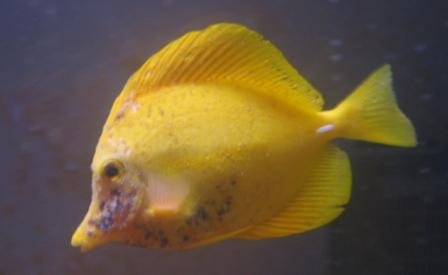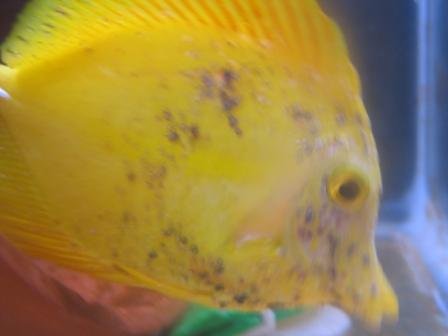peterac
Aquarium Advice Activist
Background info:
I introduced a Yellow Tang and a Copas Tang into QT right after purchasing them. I have been very vigilant about quarantining all new arrivals and I am yet to have an outbreak in my main. I immediately started hypo, gradually lowering the sq to 1.009. Everything looked good for about 2 weeks and then I noticed small white salt specks on the Yellow Tang. I continued hyo patiently for another week or so and things started to look worse and the Copas also started to show signs of white specks. They have been in the tank fo about 7-8 weeks total time so far and the Yellow Tang looks the worst. I can't seem to identify the exact parasite. The Copas has a little bit of white specking but the Yellow Tang has become inundated with raised areas that almost look like seeds. They are darkest around the outer part of the lesions. The Copas only has the white specks. They are both eating very well. I have not treated with Copper at all.
Thoughts:
I am wondering if I need to go to Copper. My biological filtration is well established. If I do go to Copper should I removed by biowheels on my Emperor filter before adding the Copper or should I let the biofiltration slowly get removed on its own? I was thinking that it would be good if I could remove the established biowheels and put them in a smaller tank I have with an airstone so that I could put them back after treating with Copper and go back to hypo without Copper?
When the biofiltation does get wiped out how I deal with Ammonia and Nitrites? Will I have to do daily water changes?
Other info:
Are Copas Tangs hardier then Yellows?
I did use a refractometer for my sg measurments.
I am confused where to go from here. I do not know if I should continue with just hypo or go to Copper. If I do go to Copper I do not know what the best course of action should be.
Any help will be greatly appreciated.
Thanks,
Pete R.
I introduced a Yellow Tang and a Copas Tang into QT right after purchasing them. I have been very vigilant about quarantining all new arrivals and I am yet to have an outbreak in my main. I immediately started hypo, gradually lowering the sq to 1.009. Everything looked good for about 2 weeks and then I noticed small white salt specks on the Yellow Tang. I continued hyo patiently for another week or so and things started to look worse and the Copas also started to show signs of white specks. They have been in the tank fo about 7-8 weeks total time so far and the Yellow Tang looks the worst. I can't seem to identify the exact parasite. The Copas has a little bit of white specking but the Yellow Tang has become inundated with raised areas that almost look like seeds. They are darkest around the outer part of the lesions. The Copas only has the white specks. They are both eating very well. I have not treated with Copper at all.
Thoughts:
I am wondering if I need to go to Copper. My biological filtration is well established. If I do go to Copper should I removed by biowheels on my Emperor filter before adding the Copper or should I let the biofiltration slowly get removed on its own? I was thinking that it would be good if I could remove the established biowheels and put them in a smaller tank I have with an airstone so that I could put them back after treating with Copper and go back to hypo without Copper?
When the biofiltation does get wiped out how I deal with Ammonia and Nitrites? Will I have to do daily water changes?
Other info:
Are Copas Tangs hardier then Yellows?
I did use a refractometer for my sg measurments.
I am confused where to go from here. I do not know if I should continue with just hypo or go to Copper. If I do go to Copper I do not know what the best course of action should be.
Any help will be greatly appreciated.
Thanks,
Pete R.


